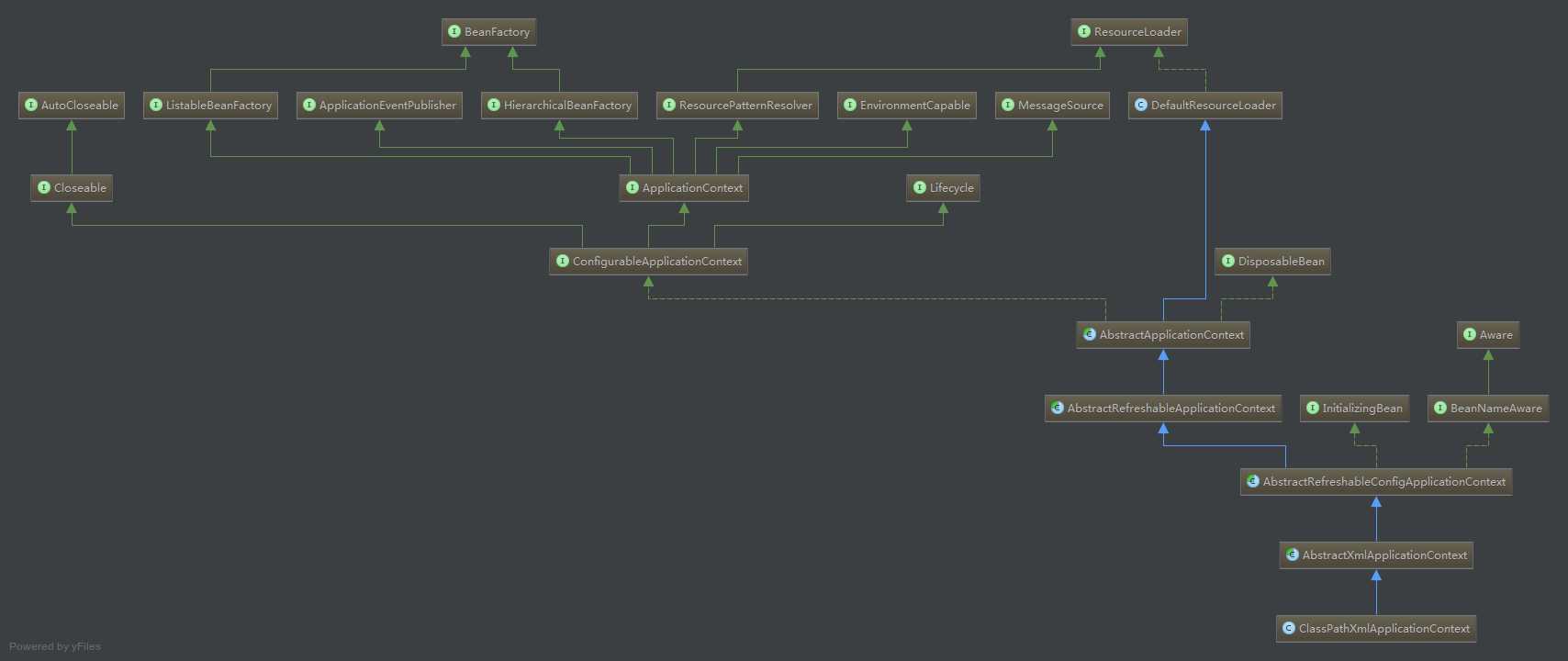标签:工作 context 注册表 object spring框架 try 日志 处理器 eset
我们知道启动spring容器两常见的两种方式(其实都是加载spring容器的xml配置文件时启动的):
1.在应用程序下加载
ApplicationContext ctx = new ClassPathXmlApplicationContext("spring-context.xml");
2.web模式下加载
<context-param> <param-name>contextConfigLocation</param-name> <param-value>classpath:spring-context.xml</param-value> </context-param> <listener> <listener-class>org.springframework.web.context.ContextLoaderListener</listener-class> </listener>
可以发现,执行new ClassPathXmlApplicationContext()的时候会打印以下日志:
2017-5-15 12:48:48 org.springframework.context.support.AbstractApplicationContext prepareRefresh
即调用AbstractApplicationContext类的prepareRefresh方法,我们去看AbstractApplicationContext类:
通过类图可以发现AbstractApplicationContext是一个抽象类,也属于BeanFactory体系,实现了ApplicationContext,再往下找到他的子类ClassPathXmlApplicationContext,来看它的具体实现
类里有很多重载的构造函数,到最后都是调用这个:
public ClassPathXmlApplicationContext(String[] paths, Class clazz, ApplicationContext parent) throws BeansException { super(parent); Assert.notNull(paths, "Path array must not be null"); Assert.notNull(clazz, "Class argument must not be null"); this.configResources = new Resource[paths.length]; for (int i = 0; i < paths.length; i++) { this.configResources[i] = new ClassPathResource(paths[i], clazz); }
//IOC初始化过程 refresh(); }
这里就到重点了,refresh方法定义了ioc容器启动的整个过程,来看源码
public void refresh() throws BeansException, IllegalStateException { synchronized (this.startupShutdownMonitor) { // 1.Prepare this context for refreshing. prepareRefresh(); // 2.Tell the subclass to refresh the internal bean factory. ConfigurableListableBeanFactory beanFactory = obtainFreshBeanFactory(); // 3.Prepare the bean factory for use in this context. prepareBeanFactory(beanFactory); try { 4.// Allows post-processing of the bean factory in context subclasses. postProcessBeanFactory(beanFactory); 5.// Invoke factory processors registered as beans in the context. invokeBeanFactoryPostProcessors(beanFactory); 6.// Register bean processors that intercept bean creation. registerBeanPostProcessors(beanFactory); 7.// Initialize message source for this context. initMessageSource(); 8.// Initialize event multicaster for this context. initApplicationEventMulticaster(); 9.// Initialize other special beans in specific context subclasses. onRefresh(); 10.// Check for listener beans and register them. registerListeners(); 11.// Instantiate all remaining (non-lazy-init) singletons. finishBeanFactoryInitialization(beanFactory); //12. Last step: publish corresponding event. finishRefresh(); } catch (BeansException ex) { // 13.Destroy already created singletons to avoid dangling resources. destroyBeans(); // 14.Reset ‘active‘ flag. cancelRefresh(ex); // 15.Propagate exception to caller. throw ex; } } }
接下来,一步一步分析spring干了哪些事
1.初始化BeanFactory:根据配置文件实例化BeanFactory,getBeanFactory()方法由具体子类实现。在这一步里,Spring将配置文件的信息解析成为一个个的BeanDefinition对象并装入到容器的Bean定义注册表(BeanDefinitionRegistry)中,但此时Bean还未初始化;obtainFreshBeanFactory()会调用自身的refreshBeanFactory(),而refreshBeanFactory()方法由子类AbstractRefreshableApplicationContext实现,该方法返回了一个创建的DefaultListableBeanFactory对象,这个对象就是由ApplicationContext管理的BeanFactory容器对象。这一步的操作相当于,如果我们在自己的应用代码中不用ApplicationContext而直接用BeanFactory时创建BeanFactory对象的操作,核心代码如下:
reader.loadBeanDefinitions(configLocations);
2.调用工厂后处理器,根据反射机制从BeanDefinitionRegistry中找出所有BeanFactoryPostProcessor类型的Bean,并调用其postProcessBeanFactory()接口方法。经过第一步加载配置文件,已经把配置文件中定义的所有bean装载到BeanDefinitionRegistry这个Beanfactory中,对于ApplicationContext应用来说这个BeanDefinitionRegistry类型的BeanFactory就是Spring默认的DefaultListableBeanFactory
public class DefaultListableBeanFactory extends AbstractAutowireCapableBeanFactory implements ConfigurableListableBeanFactory, BeanDefinitionRegistry{}
在这些被装载的bean中,若有类型为BeanFactoryPostProcessor的bean(配置文件中配置的),则将对应的BeanDefinition生成BeanFactoryPostProcessor对象容器扫描BeanDefinitionRegistry中的BeanDefinition,使用java反射自动识别出Bean工厂后处理器(实现BeanFactoryPostProcessor接口)的bean,然后调用这些bean工厂后处理器对BeanDefinitionRegistry中的BeanDefinition进行加工处理,可以完成以下两项工作(当然也可以有其他的操作,用户自己定义):
1).对使用到占位符的<bean>元素标签进行解析,得到最终的配置值,这意味着对一些半成品式的BeanDefinition对象进行加工处理并取得成品的BeanDefinition对象。
2).对BeanDefinitionRegistry中的BeanDefinition进行扫描,通过Java反射机制找出所有属性编辑器的Bean(实现java.beans.PropertyEditor接口的Bean),并自动将它们注册到Spring容器的属性编辑器注册表中(PropertyEditorRegistry),这个Spring提供了实现:CustomEditorConfigurer,它实现了BeanFactoryPostProcessor,用它来在此注册自定义属性编辑器,核心代码如下:
protected void invokeBeanFactoryPostProcessors(ConfigurableListableBeanFactory beanFactory) { // Invoke factory processors registered with the context instance. for (Iterator it = getBeanFactoryPostProcessors().iterator(); it.hasNext();) { BeanFactoryPostProcessor factoryProcessor = (BeanFactoryPostProcessor) it.next(); factoryProcessor.postProcessBeanFactory(beanFactory); } // Do not initialize FactoryBeans here: We need to leave all regular beans // 通过ApplicatinContext管理的beanfactory获取已经注册的BeanFactoryPostProcessor类型的bean的名字 String[] factoryProcessorNames = beanFactory.getBeanNamesForType(BeanFactoryPostProcessor.class, true, false); // Separate between BeanFactoryPostProcessors that implement the Ordered // interface and those that do not. List orderedFactoryProcessors = new ArrayList(); List nonOrderedFactoryProcessorNames = new ArrayList(); for (int i = 0; i < factoryProcessorNames.length; i++) { if (isTypeMatch(factoryProcessorNames[i], Ordered.class)) { // 调用beanfactory的getBean取得所有的BeanFactoryPostProcessor对象 orderedFactoryProcessors.add(beanFactory.getBean(factoryProcessorNames[i])); } else { nonOrderedFactoryProcessorNames.add(factoryProcessorNames[i]); } } // First, invoke the BeanFactoryPostProcessors that implement Ordered. Collections.sort(orderedFactoryProcessors, new OrderComparator()); for (Iterator it = orderedFactoryProcessors.iterator(); it.hasNext();) { BeanFactoryPostProcessor factoryProcessor = (BeanFactoryPostProcessor) it.next(); // 执行BeanFactoryPostProcessor的方法,传入当前持有的beanfactory对象,以获取要操作的 // BeanDefinition factoryProcessor.postProcessBeanFactory(beanFactory); } // Second, invoke all other BeanFactoryPostProcessors, one by one. for (Iterator it = nonOrderedFactoryProcessorNames.iterator(); it.hasNext();) { String factoryProcessorName = (String) it.next(); ((BeanFactoryPostProcessor) getBean(factoryProcessorName)). postProcessBeanFactory(beanFactory); } }
BeanFactoryPostProcessor接口代码如下,实际的操作由用户扩展并配置:
public interface BeanFactoryPostProcessor { /** * Modify the application context‘s internal bean factory after its standard */ void postProcessBeanFactory(ConfigurableListableBeanFactory beanFactory) throws BeansException; }
3.注册Bean后处理器,根据反射机制从BeanDefinitionRegistry中找出所有BeanPostProcessor类型的Bean,并将它们注册到容器Bean后处理器的注册表中,AbstractApplicatinContext中对应代码如下:
protected void registerBeanPostProcessors(ConfigurableListableBeanFactory beanFactory) { String[] processorNames = beanFactory.getBeanNamesForType(BeanPostProcessor.class, true, false); // Register BeanPostProcessorChecker that logs an info message when int beanProcessorTargetCount = beanFactory.getBeanPostProcessorCount() + 1 + processorNames.length; beanFactory.addBeanPostProcessor(new BeanPostProcessorChecker(beanFactory, beanProcessorTargetCount)); List orderedProcessors = new ArrayList(); List nonOrderedProcessorNames = new ArrayList(); for (int i = 0; i < processorNames.length; i++) { if (isTypeMatch(processorNames[i], Ordered.class)) { orderedProcessors.add(getBean(processorNames[i])); } else { nonOrderedProcessorNames.add(processorNames[i]); } } // First, register the BeanPostProcessors that implement Ordered. Collections.sort(orderedProcessors, new OrderComparator()); for (Iterator it = orderedProcessors.iterator(); it.hasNext();) { // 注册bean后处理器,该方法定义于ConfigurableBeanFactory接口 beanFactory.addBeanPostProcessor((BeanPostProcessor) it.next()); } // Second, register all other BeanPostProcessors, one by one. for (Iterator it = nonOrderedProcessorNames.iterator(); it.hasNext();) { String processorName = (String) it.next(); beanFactory.addBeanPostProcessor((BeanPostProcessor) getBean(processorName)); } }
整段代码类似于第三步的调用工厂后处理器,区别之处在于,工厂后处理器在获取后立即调用,而Bean后处理器在获取后注册到上下文持有的beanfactory中,供以后操作调用(在用户获取bean的过程中,对已经完成属性设置工作的Bean进行后续加工,他加工的是bean,而工厂后处理器加工的是BeanDefinition)BeanPostProcessor 接口代码如下,实际的操作由用户扩展并配置:
public interface BeanPostProcessor { Object postProcessBeforeInitialization(Object bean, String beanName) throws BeansException; Object postProcessAfterInitialization(Object bean, String beanName) throws BeansException; }
4.初始化消息源,初始化容器的国际化信息资源,源代码如下:
protected void initMessageSource() { // 具体实现 }
5.初始化应用上下文事件广播器;(观察者模式中的具体主题角色,持有观察者角色的集合,称为注册表)AbstractApplciationContext拥有一个applicationEventMulticaster 成员变量,applicationEventMulticaster 提供了容器监听器的注册表,成其为事件广播器。在第七步中将会将事件监听器装入其中,AbstractApplicationContext中的代码如下:
protected void initApplicationEventMulticaster() { // "applicationEventMulticaster",先看配置文件中有无配置该类型类(用户扩展 扩展点,如何扩展) if (containsLocalBean(APPLICATION_EVENT_MULTICASTER_BEAN_NAME)) { this.applicationEventMulticaster = (ApplicationEventMulticaster) getBean(APPLICATION_EVENT_MULTICASTER_BEAN_NAME, ApplicationEventMulticaster.class); } else { // 若没有,则应用Spring框架提供的事件广播器实例 this.applicationEventMulticaster = new SimpleApplicationEventMulticaster(); } } public boolean containsLocalBean(String name) { return getBeanFactory().containsLocalBean(name); } public Object getBean(String name, Class requiredType) throws BeansException { return getBeanFactory().getBean(name, requiredType); }
Spring初始化事件广播器,用户可以在配置文件中为容器定义一个自定义的事件广播器(bean的名称要为"applicationEventMulticaster"),只要实现ApplicationEventMulticaster就可以了,Spring在此会根据beanfactory自动获取。如果没有找到外部配置的事件广播器,Spring使用SimpleApplicationEventMulticaster作为事件广播器。
6.初始化其他特殊的Bean:这是一个钩子方法,子类可以借助这个钩子方法执行一些特殊的操作,如AbstractRefreshableWebApplicationContext就使用该钩子方法执行初始化ThemeSource的操作;
protected void onRefresh() throws BeansException { // For subclasses: do nothing by default. }
7.注册事件监听器;(观察者模式中的观察者角色)
Spring根据上下文持有的beanfactory对象,从它的BeanDefinitionRegistry中找出所有实现org.springfamework.context.ApplicationListener的bean,将BeanDefinition对象生成bean,注册为容器的事件监听器,实际的操作就是将其添加到事件广播器所提供的监听器注册表中
AbstractApplicationContext中的代码如下:
/** Statically specified listeners */ private List applicationListeners = new ArrayList(); public List getApplicationListeners() { return this.applicationListeners; } protected void registerListeners() { // Register statically specified listeners first. for (Iterator it = getApplicationListeners().iterator(); it.hasNext();) { addListener((ApplicationListener) it.next()); } // 获取ApplicationListener类型的所有bean,即事件监听器 // uninitialized to let post-processors apply to them! Collection listenerBeans = getBeansOfType(ApplicationListener.class, true, false).values(); for (Iterator it = listenerBeans.iterator(); it.hasNext();) { // 将事件监听器装入第五步初始化的事件广播器 addListener((ApplicationListener) it.next()); } } public Map getBeansOfType(Class type, boolean includePrototypes, boolean allowEagerInit) throws BeansException { return getBeanFactory().getBeansOfType(type, includePrototypes, allowEagerInit); } protected void addListener(ApplicationListener listener) { getApplicationEventMulticaster().addApplicationListener(listener); }
ApplicationListener 的源代码如下:
/** * Interface to be implemented by application event listeners. * @see org.springframework.context.event.ApplicationEventMulticaster */ public interface ApplicationListener extends EventListener { void onApplicationEvent(ApplicationEvent event); }
8.初始化singleton的Bean:实例化所有singleton的Bean,并将它们放入Spring容器的缓存中;这就是和直接在应用中使用BeanFactory的区别之处,在创建ApplicationContext对象时,不仅创建了一个BeanFactory对象,并且还应用它实例化所有单实例的bean。(在spring的配置文件中,bean默认为单例,除非在bean的配置中显式指定scope="prototype")
AbstractApplicationContext中的代码如下:
beanFactory.preInstantiateSingletons();
9.发布上下文刷新事件:在此处时容器已经启动完成,发布容器refresh事件(ContextRefreshedEvent)
创建上下文刷新事件,事件广播器负责将些事件广播到每个注册的事件监听器中。
publishEvent(new ContextRefreshedEvent(this)); public void publishEvent(ApplicationEvent event) { Assert.notNull(event, "Event must not be null"); // 在此获取事件广播器,并调用其方法发布事件:调用所有注册的监听器的方法 getApplicationEventMulticaster().multicastEvent(event); if (this.parent != null) { this.parent.publishEvent(event); } }
至此,ApplicationContext对象就完成了初始化工作:创建BeanFactory来装配BeanDefiniton,加工处理BeanDefiniton,注册了bean后处理器,初始化了消息资源,初始化了应用上下文事件广播器,注册了事件监听器,初始化了所有singleton的bean,最后发布上下文刷新事件。
标签:工作 context 注册表 object spring框架 try 日志 处理器 eset
原文地址:http://www.cnblogs.com/hechao123/p/6841046.html